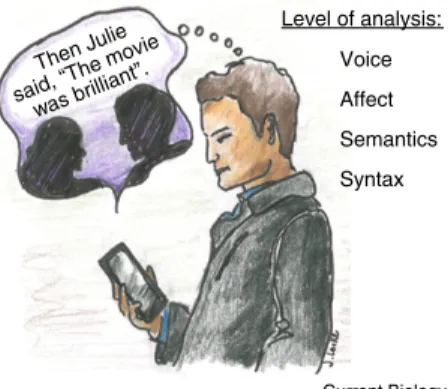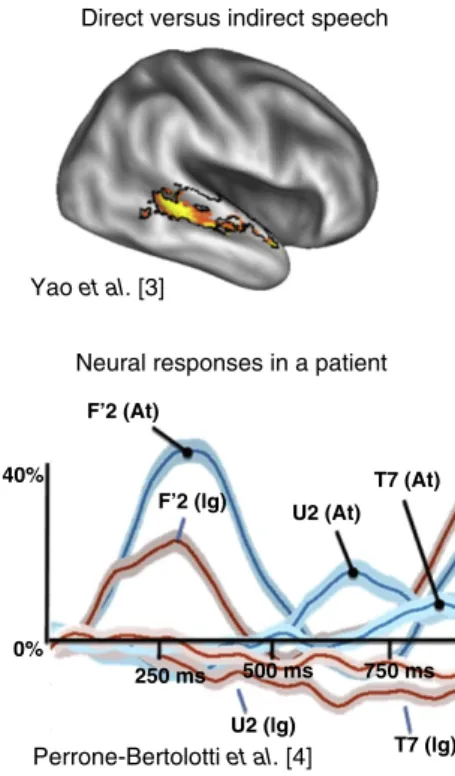HAL Id: hal-02008911
https://hal-amu.archives-ouvertes.fr/hal-02008911
Submitted on 6 Feb 2019
HAL is a multi-disciplinary open access
archive for the deposit and dissemination of
sci-entific research documents, whether they are
pub-lished or not. The documents may come from
teaching and research institutions in France or
abroad, or from public or private research centers.
L’archive ouverte pluridisciplinaire HAL, est
destinée au dépôt et à la diffusion de documents
scientifiques de niveau recherche, publiés ou non,
émanant des établissements d’enseignement et de
recherche français ou étrangers, des laboratoires
publics ou privés.
Distributed under a Creative Commons Attribution| 4.0 International License
Silent Reading: Does the Brain ‘Hear’ Both Speech and
Voices?
Christopher Petkov, Pascal Belin
To cite this version:
Christopher Petkov, Pascal Belin. Silent Reading: Does the Brain ‘Hear’ Both Speech and Voices?.
Current Biology - CB, Elsevier, 2013, 23 (4), pp.R155-R156.
�10.1016/j.cub.2013.01.002�.
Silent Reading: Does the Brain ‘Hear’
Both Speech and Voices?
Silent reading is a private experience that plays out in our imagination. Although we might primarily read for content, recent human brain neuroimaging and neuronal recording work is revealing the inner processes at play. Some of these involve experiencing voices.
Christopher I. Petkov1
and Pascal Belin2
When we curl up with a book or use our mobile device to check the latest social and world news, we partly disengage from the external world. Silent reading engulfs us in an individually unique experience where learned symbols are used to create meaning and imagined situations. Which brain processes does silent reading engage? For many years research into understanding the processes involved in silent
reading has focused on the language content in written text (Figure 1, semantics and syntax). Such work has greatly informed us on the processing of the distributed language-comprehension network in the brain[1]. Other research suggests that the brain uses ‘top-down’ cognitive influences to stimulate sensory brain regions[2,3]and neuronal populations[4]. Thus, when silent reading creates an imagined experience, new research work is revealing how the brain simulates aspects of the situations being described by the words on the page. This includes activating brain regions that would respond to voices or emotions (Figure 1).
When we read direct quotations, voice-sensitive brain regions can be activated, even when the quotation is from a fictional person and the voice is unknown. For instance, direct speech is a sentence that includes a quote, such as: Tom said, ‘‘The game was interesting’’. This creates a more vivid experience than reading a content-matched indirect speech equivalent, such as: Tom said that the game was interesting. Does a more vivid experience involve experiencing voices?
Yao et al.[2]asked whether direct speech would selectively activate brain regions that are known to respond to voices. They used functional magnetic-resonance
imaging (fMRI) to scan the brains of participants as they read
content-matched direct and indirect speech phrases. Moreover, the brain regions sensitive to voices were localized in each participant. The researchers observed that parts of the voice-sensitive regions, in the superior–mid to posterior–right temporal lobe, were selectively activated by the direct speech[2]
(also see[3]andFigure 2top). This result suggests that internal ‘top down’ brain processes were activating brain regions that would normally respond to a heard voice. However, because the imagined people in the read phrases were fictitious, it seems that a more general ‘inner’ voice is simulated rather than the voice of a specific individual[5]. Interestingly, individual voice-identity[6,7]and face-identity sensitive regions[8]are thought to reside in more anterior temporal lobe regions. Thus the ‘inner’ voice results appear to engage more posterior temporal lobe regions that are known to be sensitive to the categorical difference between voice and non-voice sounds. Whether silent reading would also engage face-category sensitive brain regions in the fusiform gyrus is to our knowledge a hypothesis ripe for testing.
Because of the sluggish temporal resolution of fMRI, the previous studies could not provide insights into the neuronal time course during silent reading. It has also not been clear how attention to particular words (as a top-down cognitive influence) would affect the amplitude and latency of neuronal responses. Answers to these issues have come from the recent work of Perrone-Bertolotti et al.[4], who recorded from intra-cranial electrodes in four epilepsy patients. As part of the patients’ surgical planning for pharmacologically resistant epilepsy, depth-electrode recordings
provide the neurological care team with crucial information on epileptic sites. During the long periods of monitoring, it is sometimes possible for researchers to engage the patients in an interesting task and to obtain neuronal responses associated with task performance.
Perrone-Bertolotti et al.[4]recorded neuronal responses as the patients silently read and attended to one of two different types of phrases that were coloured either in gray or white text. The words from each of the two phrases were alternated and presented individually (for 700 ms each) on a black screen, and the patients were asked to attend to only the words of the cued phrase (in either gray or white text). The electrodes in the four patients were at sites around hierarchically higher-level auditory cortical regions in the left and right superior-temporal gyrus and
sulcus, which contain voice-sensitive regions. The results showed that attention strongly modulated auditory neuronal responses in these regions during silent reading[4](Figure 2
bottom).
In one of the patients, electrodes were available in three brain regions, allowing the investigators an opportunity to evaluate the timing of the regional brain response in one visual and two auditory cortical regions. One would expect that, during silent reading, visual cortex would respond first to the written text (as it would to a visual sensory
Then Julie said, “The movie
was brilliant”. Voice Affect Semantics Syntax Level of analysis: Current Biology
Figure 1. Experiences during silent reading. Silent reading not only engages language processes for evaluating meaning (semantics) and grammar (syntax), but also voice sensitive and affective regions in the brain.
Dispatch R155
stimulus). But would then primary auditory cortex respond followed by a hierarchically higher-level auditory region, or vice versa? Moreover, could all three of these regions be modulated by attention to the text?
Perrone-Bertolotti et al.[4]found that word reading activated visual cortex first (w300 ms; F’2 electrode in
Figure 2bottom) followed by primary auditory cortex (w700 ms; U2 electrode). The higher-level auditory region responded with the longest latency (w800 ms; T7 electrode). Moreover, attention seemed well able to modulate the responses of all three of the sites (Figure 2bottom), and Granger causality analyses showed that attentional effects in visual cortex seemed to influence auditory cortical responses 400–550 ms
following word onset[4]. These findings suggest that cross-sensory input from visual cortex into auditory cortex and/or top-down attentional influences modulate regions around primary auditory cortex before modulating higher-level auditory areas.
Although the findings from this patient are extremely interesting, they also highlight the challenges of conducting neuronal recordings in human patients. This younger patient scored poorly on verbal comprehension. Thus, the clinical environment or the severity of the epilepsy may have affected her ability to stay on top of her education. Perrone-Bertolotti et al.[4]
therefore suggest that this patient’s results might not reflect those that would be obtained from a skilled reader. Yet, because of this the results are relevant for understanding neuronal processes in individuals with reading and language difficulties or those at earlier stages of reading competency.
Given the challenges inherent in conducting neuronal recordings from human patients[4], one wonders whether an animal model could be developed to improve our understanding of the general neuronal mechanisms. An animal that can read would only exist in fiction. However, given that voice-sensitive brain regions are observed in humans[6,7,9]and monkeys[10], and that the primate brain appears to contain voice-sensitive cells[9], an animal model could address whether and how certain visual scenarios modulate the responses of
voice-sensitive neurons when sound is not present.
Theories of embedded cognition propose that perceptual simulation is an important aspect of normal cognitive function[11]. The new work that we have considered on silent reading[4]seems to be
providing evidence in support of such theories. Moreover, neurobiological work in this field is relevant for understanding aspects of major clinical disorders. Possibly, better understanding impaired internal processes might inform us on the aberrant speech and voice symptoms experienced by certain schizophrenic patients, or the disrupted internalization processes
faced by depressed individuals who find it difficult to engage with the external world[12]. Thereby, research into the neuronal processes involved in silent reading not only provides a glimpse into the neurobiology of creativity and imagination, but could also generate insights on how to improve aberrant processes, such as those that prevent an individual from engaging or disengaging with reality.
References
1. Friederici, A.D. (2011). The brain basis of language processing: from structure to function. Physiol. Rev. 91, 1357–1392. 2. Yao, B., Belin, P., and Scheepers, C. (2011).
Silent reading of direct versus indirect speech activates voice-selective areas in the auditory cortex. J. Cogn. Neurosci. 23, 3146–3152.
3. Yao, B., Belin, P., and Scheepers, C. (2012). Brain ‘talks over’ boring quotes:
top-down activation of voice-selective areas while listening to monotonous direct speech quotations. Neuroimage 60, 1832–1842.
4. Perrone-Bertolotti, M., Kujala, J., Vidal, J.R., Hamame, C.M., Ossandon, T., Bertrand, O., Minotti, L., Kahane, P., Jerbi, K., and Lachaux, J.P. (2012). How silent is silent reading? Intracerebral evidence for top-down activation of temporal voice areas during reading. J. Neurosci. 32, 17554–17562.
5. Kurby, C.A., Magliano, J.P., and Rapp, D.N. (2009). Those voices in your head: activation of auditory images during reading. Cognition 112, 457–461.
6. Belin, P., and Zatorre, R.J. (2003). Adaptation to speaker’s voice in right anterior temporal lobe. Neuroreport 14, 2105–2109.
7. von Kriegstein, K., Eger, E., Kleinschmidt, A., and Giraud, A.L. (2003). Modulation of neural responses to speech by directing attention to voices or verbal content. Brain Res. Cogn. Brain Res. 17, 48–55.
8. Kriegeskorte, N., Formisano, E., Sorger, B., and Goebel, R. (2007). Individual faces elicit distinct response patterns in human anterior temporal cortex. Proc. Natl. Acad. Sci. USA 104, 20600–20605.
9. Perrodin, C., Kayser, C., Logothetis, N.K., and Petkov, C.I. (2011). Voice cells in the primate temporal lobe. Curr. Biol. 21, 1408–1415.
10. Petkov, C.I., Kayser, C., Steudel, T., Whittingstall, K., Augath, M., and Logothetis, N.K. (2008). A voice region in the monkey brain. Nat. Neurosci. 11, 367–374.
11. Barsalou, L.W. (1999). Perceptual symbol systems. Behav. Brain Sci. 22, 577–609, discussion 610–560.
12. Northoff, G. (2011). Self and brain: what is self-related processing? Trends Cogn. Sci. 15, 186–187, author reply 187–188.
1Institute of Neuroscience, Newcastle
University, Newcastle upon Tyne, UK.
2Department of Psychology, Glasgow
University, Glasgow, UK. E-mail:chris.petkov@ncl.ac.uk,
p.belin@psy.gla.ac.uk
http://dx.doi.org/10.1016/j.cub.2013.01.002
Direct versus indirect speech
Yao et al. [3]
Neural responses in a patient
Perrone-Bertolotti et al. [4] F’2 (At) 40% 0% U2 (lg) T7 (lg) Current Biology F’2 (lg) U2 (At) T7 (At) 250 ms 500 ms 750 ms
Figure 2. Regional brain and neuronal processes during silent reading.
(Top) Black outline shows brain regions activated for vocal vs. non-vocal sounds. Within this ‘voice-sensitive’ region, direct speech elicits a greater brain activity response (yellow to red colormap) than indirect speech. Reproduced with permission from [3]. (Bottom) Neuronal recordings from 3 brain regions in a human patient (visual cortex: F’2 electrode trace; primary auditory cortex: U2; hierarchically higher-level auditory cortex T7); blue traces are attended text, red traces are ignored text. Reproduced with permission from[4].
Current Biology Vol 23 No 4 R156

